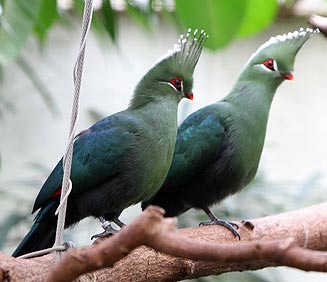|
Tauraco livingstonii
(Livingstone's turaco)
Mosambiekloerie [Afrikaans]; iGwalagwala (also applied
to Knysna and Purple-crested turacos) [Zulu]; Touraco de Livingstone [French];
Langschopfturako [German]; Turaco de Livingstone [Portuguese]
Life
> Eukaryotes >
Opisthokonta
> Metazoa (animals) >
Bilateria >
Deuterostomia > Chordata >
Craniata > Vertebrata (vertebrates) > Gnathostomata (jawed
vertebrates) > Teleostomi (teleost fish) > Osteichthyes (bony fish) > Class:
Sarcopterygii (lobe-finned
fish) > Stegocephalia (terrestrial
vertebrates) > Tetrapoda
(four-legged vertebrates) > Reptiliomorpha > Amniota >
Reptilia (reptiles) >
Romeriida > Diapsida > Archosauromorpha > Archosauria >
Dinosauria
(dinosaurs) > Saurischia > Theropoda (bipedal predatory dinosaurs) >
Coelurosauria > Maniraptora > Aves
(birds) >
Musophagiformes > Family: Musophagidae
 |
 |
|
Livingstone's turaco, Artis Amsterdam Zoo, The
Netherlands. [photo Arjan Haverkamp ©] |
Livingstone's turaco, Cape Vidal, iSimangaliso
Wetland Reserve, South Africa. [photo Alan Manson
©] |
Distribution and habitat
Occurs from Tanzania and Malawi to southern Africa, where it
is fairly common in Zimbabwe's eastern highlands, central and southern
Mozambique and KwaZulu-Natal. It generally prefers Afromontane evergreen forest, riverine forest and thickets.
Movements and migrations
Resident and largely sedentary, although it may
make local movements in response to the availability of fruiting
trees.
Food
Mainly eats fruit, supplemented with other plant matter,
doing most of its foraging in the tree canopy or occasionally in the understorey of fruiting
trees. The following food items have been recorded
in its diet:
- Plants
- fruit
- Ochna atropurpurea (Large-flowered ochna)
- Afrocrania volkensii (Afrocrania)
- Englerophytum natelense (Silver-leaved milkplum)
- Bridelia micrantha (Mitzeerie)
- Chionanthus battiscombei (Water pock-ironwood)
- Cola greenwayi (Hairy cola)
- Cussonia spicata (Cabbage-tree)
- Ehretia cymosa (Forest stamperwood)
- Ficus (figs)
- Ficus exasperata (Sandpaper forest fig)
- Ficus scassellatii (Crown-fruit fig)
- Ficus natelensis (Coastal strangler fig)
- Ficus sansibarica (Knobbly fig)
- Rubus ellipticus (bramble)
- Schefflera umbellifera (False cabbage-tree)
- Trema orientalis (Pigeonwood)
- flowerheads of Cussonia (cabbage-trees)
- buds of Bauhinia (bauhinia trees)
Breeding
- Monogamous, territorial solitary nester, although the structure of the
nest has never been recorded.
- Egg-laying season is from August-February, peaking from October-January;
it typically lays two eggs.
Threats
Not threatened.
References
-
Hockey PAR, Dean WRJ and Ryan PG 2005. Roberts
- Birds of southern Africa, VIIth ed. The Trustees of the John Voelcker
Bird Book Fund, Cape Town.
|
